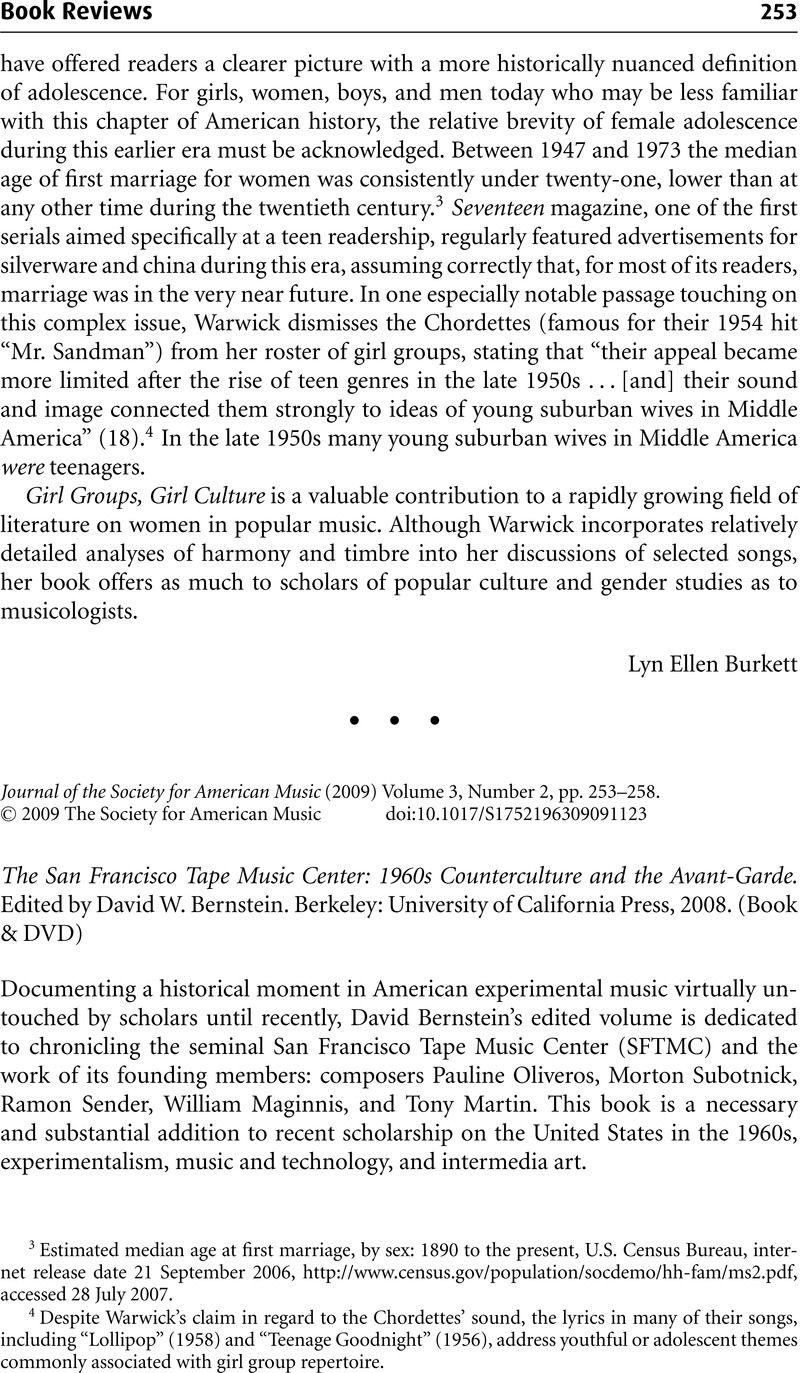No CrossRef data available.
Article contents
The San Francisco Tape Music Center: 1960s Counterculture and the Avant-Garde. Edited by David W. Bernstein. Berkeley: University of California Press, 2008. (Book & DVD)
Published online by Cambridge University Press: 01 May 2009
Abstract

- Type
- Book Review
- Information
- Copyright
- Copyright © The Society for American Music 2009
References
1 For more information on other electronic music studios active at the time, see Davies, Hugh, Repertoire International des Musiques Electroacoustiques. International Electronic Music Catalog (Cambridge, Mass.: MIT Press, 1968)Google Scholar.
2 For example, Chadabe, Joel, Electric Sound: The Past and Promise of Electronic Music (Upper Saddle River, N.J.: Prentice Hall, 1997)Google Scholar; Pinch, Trevor and Trocco, Frank, Analog Days: The Invention and Impact of the Moog Synthesizer (Cambridge, Mass.: Harvard University Press, 2002)Google Scholar; Manning, Peter, Electronic and Computer Music (New York: Oxford University Press, 2004)CrossRefGoogle Scholar; and Holmes, Thom, Electronic and Experimental Music (New York: Routledge, 2008)Google Scholar.
3 Banes, Sally, Greenwich Village 1963: Avant-Garde Performance and the Effervescent Body (Durham, N.C.: Duke University Press, 1993)Google Scholar; Hendricks, Geoffrey, ed., Critical Mass: Happenings, Fluxus, Performance, Intermedia and Rutgers University 1958–1972 (New Brunswick, N.J.: Rutgers University Press, 2003)Google Scholar; Looker, Benjamin, Point from Which Creation Begins: The Black Artists' Group of St. Louis (Jefferson City, Mo.: Missouri Historical Society Press, 2004)Google Scholar; and Joseph, Branden, Beyond the Dream Syndicate: Tony Conrad and the Arts after Cage (New York: Zone Books, 2008)Google Scholar.
4 For more on Fluxus and the ONCE festivals, see Mumma, Gordon, “The Once Group and How It Happened,” Arts in Society 4/2 (1967): 380–98Google Scholar; James, Richard, “ONCE: Microcosm of the 1960s Musical and Multimedia Avant-Garde,” American Music 5/4 (1987): 359–90CrossRefGoogle Scholar; Smith, Owen F., Fluxus: The History of an Attitude (San Diego, Calif.: San Diego State University Press, 1998)Google Scholar; and Miller, Leta E., “ONCE and Again: The Evolution of a Legendary Festival,” liner notes to Music from the ONCE Festival 1961–1966 (New York: New World Records 80567-2, 2003)Google Scholar.
5 Lesh, Phil, Searching for the Sound: My Life with the Grateful Dead (New York: Little, Brown, 2005)Google Scholar.
6 It should be noted, however, that Ramon Sender directly discusses aspects of Oliveros's struggle in his interview section, stating that “as a gay woman in the San Francisco music scene in the early 1960s, it was an absolute uphill battle for her. She had a very, very hard time” (79).
7 Significant sound and light work also took place in Ann Arbor, Michigan, with Milton Cohen's “Space Theater,” inspired by the Vortex performances and featuring music by Robert Ashley and Gordon Mumma. James's article “ONCE” includes photographs and a sizable amount of information on the Space Theater's genesis and early activities.
8 This category of improvisation has been dubbed “non-idiomatic improvisation” by Derek Bailey in Improvisation: Its Nature and Practice in Music (New York: Da Capo Press, 1993).
9 See, for example, Lewis, George, “Improvised Music after 1950: Afrological and Eurological Perspectives,” Black Music Research Journal 16/1 (Spring 1996): 91–121CrossRefGoogle Scholar.
10 Both Martin and Oliveros made the move to Mills and managed the Center for a time before leaving for other opportunities. The Mills College Center for Contemporary Music, inheritor of the SFTMC's legacy, continues to thrive and produce vital work.
11 At least three recordings created at the original SFTMC have been released commercially: on Pauline Oliveros, Electronic Works (Paradigm Discs PD04, 2006), and Ramon Sender, Worldfood (Locust 55, 2004) and Desert Ambulance (Locust 70, 2005).




